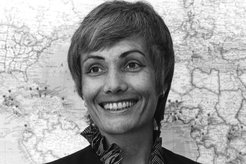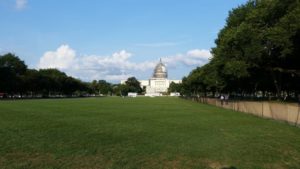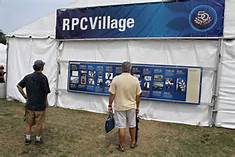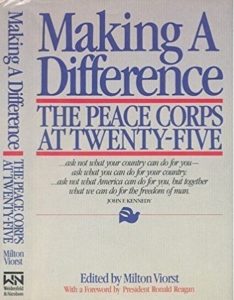The Peace Corps in the Time of Trump, Part 5
On April 27, 1979, President Carter signed an amendment to the ACTION legislation granting the Peace Corps special independence. Dick Celeste was appointed Peace Corps Director and ACTION associate director for International Operations. I’m told Bill Josephson, a New York lawyer, and one of the Mayflower Gang that created the agency in 1961 was involved in writing the amendment.
Peace returned to the Peace Corps with the appointment of Loret Miller Ruppe on May 6, 1981. She is, so far, the longest serving Peace Corps Director. In her tenure from 1981 to 1989 the budget increased almost 50%, the number of PCVs by 20%, the average attrition rate decreased significantly and according to Senator Chris Dodd (Dominican Republic 1966-68) she “took the Peace Corps out of the pit of politics and made it non-partisan.” Programs began or were renewed in 14 countries.
One of the disturbing pieces of information that Lawrence F. Lohosit (Honduras 1975-77) points out in his book, Peace Corps Chronology 1961-2010) is a study due by the agency of volunteer deaths between 1962 and 1983 70% involved vehicle accidents. However, between 1981 and 1983, suicide was the leading cause of death (13% of all volunteer deaths during that time period).
On the weekend of September 19-20th 1986, the 25tgh anniversary celebration of the Peace Corps was held on the National Mall in Washington. Over 5,000 RPCVs attended.
The anniversary was organized and staged by the RPCVs of Washington chaired at the time by Roger Landrum (Nigeria 1961-63). The RPCVs had gone to Ruppe seeking the Peace Corps help and cooperation and none was forthcoming. I was told that Ruppe was ‘terrified’ that the RPCVs would march on Reagan and the White House.
The ‘reunion’ organizers did not have the funds to program any events that might be staged on the Mall or the Peace Corps reunited at twenty-five years of service.
Then there was a chance meeting of former Peace Corps founder Harris Wofford and an official from the MacArthur Foundation of Chicago in a taxi ride from National Airport into the city.
Wofford ‘happen’ to mention the dilemma RPCVs were facing, wanting to have a reunion without the support of the agency. A week later Landrum went to the Washington, D.C. RPCV P.O. Box and found a check from the MacArthur Foundation for $25,000. The reunion was on and chaired by Doug Siglin (Zaire 1979-81).
As Roger told the massive gathering under the tent on the Mall, “We told the Peace Corps that we were going to have some fun but we were not going to burn down the White House. We saw this conference primarily as a step forward in building alumni organizations so we can have a positive impact on the Peace Corps, on foreign assistance policies, and on our country.”
And that it what happened. A Director was hired. A staff was hired. An office rented. An alumni data bank created, as well as an alumni magazine, awards created, and a community of RPCVs established. Today it is called the National Peace Corps Association (NPCA).
It was at this Peace Corps Mall Reunion that the first Peace Corps Writers panels were held to recognize and celebrate Peace Corps writers and their contributions to educating Americans about the Third World. Roger and the organization committees were reluctant to add “writers’ panels” to the program, and we never did get listed in the program, but our panels were announced from the podium and after the weekend Roger would write Marian Beil (Ethiopia 1962-64) saying, “The writers’ panels got the biggest volunteer audiences, so you were right.”
Ruppe, too, was smart enough to join forces with the Washington RPCV group and arrange for President Corazon Aquino of the Philippines to address the gathering, and to fund the writing of Making A Difference The Peace Corps at Twenty-Five, a collection of essays about the Peace Corps by former staff and volunteers from the first twenty-five years, with a foreword by President Ronald Reagan. It was edited by Milton Viorst. She also got Harry Belafonte, one of the first advisors to the agency, to host a Saturday night event at the Kennedy Center.
On a hazy Sunday morning the first of Peace Corps processions to Arlington Cemetery took place. Marching in country of service groups, and carrying host country flags, loaned by ambassadors, the RPCVs marched across the Potomac’s Memorial Bridge and paused at Kennedy’s grave. There, by the eternal flame, Alan and Judy Guskin laid a wreath of thanks to the founder.
As graduate students at the University of Michigan after hearing Kennedy’s 2 a.m. campaign speech that first enunciated the Peace Corps idea, they organized “Americans Committed to World Responsibility” and began to gather a thousand student signatures on a petition to Kennedy requesting establishment of an overseas program.
The Reunion of RPCVs on the Mall attracted international front page press. It would be the most publicity that the Peace Corps would receive until Tim Carroll (Nigeria 1963-65), then head of the National Council of Returned Peace Corps Volunteers, arranged with Chris Dodd on November 22, 1988, to stage a 24-hour vigil of readings by RPCVs and former Staff at the Capitol Rotunda. That event ended with a memorial service at St. Matthew’s Cathedral, the church where Kennedy’s funeral was held.
By the end of the decade, two other significant events happened for the Peace Corps. Women made up more than half of all PCVs. And in April of 1989, the first issue of Marian Beil & John Coyne’s RPCV Writers & Readers newsletter, was published.
In my first editorial, I wrote: “There isn’t really one good reason to publish this newsletter. Putting that aside, I’m going to do it anyway.”
I was wrong.
There is a good reason why we have been doing this newsletter, and now website, for 28 years. Our reason has not changed. We want to support and promote the poets, novelists and non-fiction writers who are telling the Peace Corps story and through their writings promoting the Third Goal of the Peace Corps.






Lorette was the first director to actually care about those who got sick and injured.
I remember Lorette describeing her first encounter with her “White House liaison” shortly after her appointment as Peace Corps Director He was an officious young man who kept her waiting , was condescending, and said as he sailed out the door, “Oh, by the way, I’ve recommended getting rid of the Peace Corps.” Lorette smiled at us and said, “I got myself another liaison…” A good woman and a good PCD.